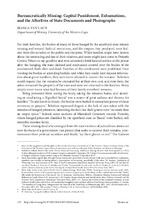| dc.contributor.author | van Laun, Bianca | |
| dc.date.accessioned | 2019-10-17T11:10:32Z | |
| dc.date.available | 2019-10-17T11:10:32Z | |
| dc.date.issued | 2018 | |
| dc.identifier.citation | van Laun, Bianca. (2018). Bureaucratically Missing: Capital Punishment, Exhumations, and the Afterlives of State Documents and Photographs. Kronos, 44(1), 123-144. https://dx.doi.org/10.17159/2309-9585/2018/v44a8 | en_US |
| dc.identifier.issn | ISSN 2309-9585 | |
| dc.identifier.uri | http://dx.doi.org/10.17159/2309-9585/2018/v44a8 | |
| dc.identifier.uri | http://hdl.handle.net/10566/5043 | |
| dc.description.abstract | For their families, the bodies of many of those hanged by the apartheid state remain missing and missed. Judicial executions, and the corpses they produced, were hidden from the scrutiny of the public and the press. While families might have known about the sentencing and fate of their relatives, and some might have come to Pretoria Central Prison to say goodbye and even attended a brief funeral service at the prison after the hanging, the state claimed and maintained control over the bodies of the condemned, both alive and dead. Families of the condemned were prohibited from viewing the bodies or attending burials, and while they could later request information about grave numbers, they were never allowed to recover the remains. Relatives could request that the remains be cremated but at their own cost, and even then, the ashes remained the property of the state and were not returned to the families. Many simply never knew what had become of their family members’ remains. | en_US |
| dc.language.iso | en | en_US |
| dc.publisher | University of the Western Cape | en_US |
| dc.subject | Apartheid | en_US |
| dc.subject | Executions | en_US |
| dc.subject | Gallows Memorialisation Project | en_US |
| dc.subject | Prisoners | en_US |
| dc.subject | Death-row | en_US |
| dc.title | Bureaucratically missing: Capital punishment, exhumations, and the afterlives of state documents and photographs | en_US |
| dc.type | Article | en_US |

